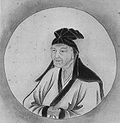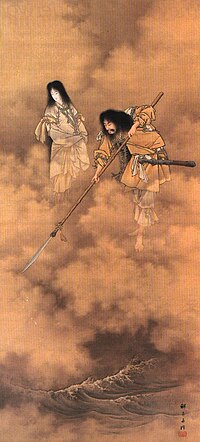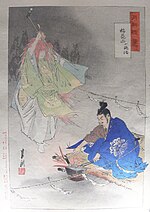Women occupy a unique role in the indigenous Japanese traditions of Shinto, including a unique form of participation as temple stewards and shamans, or...
18 KB (2,098 words) - 16:09, 4 January 2024
of Shintō such as popular Shintō, folk Shintō, domestic Shintō, sectarian Shintō, imperial house Shintō, shrine Shintō, state Shintō, new Shintō religions...
124 KB (15,736 words) - 06:46, 17 November 2024
(career woman in Japan) Overview of gender inequality in Japan Shōjo Women in agriculture in Japan Yamato nadeshiko Nyonin Kinsei Women in Shinto History:...
72 KB (8,275 words) - 12:22, 17 November 2024
Kami (redirect from Shinto gods)
spirits, mythological, spiritual, or natural phenomena that are venerated in the Shinto religion. They can be elements of the landscape, forces of nature, beings...
34 KB (4,285 words) - 16:36, 11 November 2024
Shinto weddings, Shinzen kekkon, Shinzenkekkon (神前結婚, "Marriage before the kami"), began in Japan during the early 20th century, popularized after the...
15 KB (1,820 words) - 06:49, 24 September 2024
is the glossary of Shinto, including major terms on the subject. Words followed by an asterisk (*) are illustrated by an image in one of the photo galleries...
122 KB (14,020 words) - 15:33, 6 October 2024
Shinto is a religion native to Japan with a centuries'-long history tied to various influences in origin. Although historians debate[citation needed]...
142 KB (20,195 words) - 19:00, 17 November 2024
Studies. SAGE Publications. 2012. p. 1539. ISBN 9781412994224. Shinto Shinto shrine List of Shinto shrines Buddhist Churches of America Honpa Hongwanji Mission...
6 KB (160 words) - 16:29, 14 September 2024
Confucian Shinto, also known as Juka Shintō (儒家神道) in Japanese, is a syncretic religious tradition that combines elements of Confucianism and Shinto. It originated...
7 KB (651 words) - 21:25, 11 September 2024
deities of the Shinto religion. The honden (本殿, meaning: "main hall") is where a shrine's patron kami is/are enshrined. The honden may be absent in cases where...
82 KB (9,505 words) - 08:54, 11 November 2024
Religion in Japan is manifested primarily in Shinto and in Buddhism, the two main faiths, which Japanese people often practice simultaneously. According...
76 KB (7,598 words) - 17:07, 18 November 2024
Muromachi period (redirect from Ryōbu Shinto)
Ryōbu Shinto (Dual Shinto). The Mongol invasions in the late thirteenth century, however, evoked a national consciousness of the role of the kamikaze in defeating...
22 KB (2,848 words) - 06:40, 5 September 2024
While Shinto beliefs are diverse, Japanese Shintoism does not condemn homosexuality. A variety of obscure literary references to same-sex love exist in ancient...
57 KB (6,987 words) - 08:18, 17 October 2024
Itsukushima Shrine (redirect from Itsukushima Shinto Shrine)
Shinto shrine on the island of Itsukushima (popularly known as Miyajima), best known for its "floating" torii. It is in the city of Hatsukaichi, in Hiroshima...
19 KB (1,882 words) - 07:31, 5 November 2024
Miko clothing (category Shinto religious clothing)
traditions. Although often confused with miko, there are also women among the kannushi (Shinto priests). The kannushi wear clothing different from that of...
19 KB (2,832 words) - 05:52, 18 July 2024
Kannushi (redirect from Shinto priest)
qualification. Women can also become kannushi, and widows can succeed their husbands in their job. An Onshi or Oshi (御師) is a lower level Shinto priest analogous...
6 KB (530 words) - 21:28, 11 May 2024
Japanese history. Female Shinto priests were largely pushed out of their positions in 1868. The ordination of women as Shinto priests arose again during...
172 KB (17,592 words) - 06:25, 25 October 2024
Miko (category Shinto)
works at a Shinto shrine. Miko were once likely seen as shamans, but are understood in modern Japanese culture to be an institutionalized role in daily life...
21 KB (2,345 words) - 22:51, 26 September 2024
Misogi (category Exorcism in Shinto)
Misogi (禊) is a Japanese Shinto practice of ritual purification by washing the entire body. Misogi is related to another Shinto purification ritual, harae...
6 KB (644 words) - 00:40, 23 September 2024
Comfort women were women and girls forced into sexual slavery by the Imperial Japanese Armed Forces in occupied countries and territories before and during...
261 KB (26,644 words) - 04:17, 17 November 2024
Omamori (category Shinto)
(御守/お守り) are Japanese amulets commonly sold at Shinto shrines and Buddhist temples, dedicated to particular Shinto kami as well as Buddhist figures and are...
8 KB (872 words) - 02:35, 5 August 2024
Amaterasu (category Shinto kami)
goddess of the sun in Japanese mythology. Often considered the chief deity (kami) of the Shinto pantheon, she is also portrayed in Japan's earliest literary...
79 KB (8,428 words) - 20:20, 15 November 2024
Konkokyo (category Shinto new religious movements)
is a Shinto sect, with origins in Shinbutsu-shūgō beliefs. It is part of the Kyoha Shintō Rengōkai (教派神道連合会, Association of Sectarian Shinto). Konkōkyō...
24 KB (3,430 words) - 15:03, 31 August 2024
Okinoshima (Fukuoka) (category Shinto shrines in Fukuoka Prefecture)
considered a shinto kami, and the island is off limits to women. One proposed reason is that Shinto views blood as impure and menstruation would desecrate...
12 KB (1,132 words) - 01:26, 13 April 2024
traditional stories, folktales, and beliefs that emerged in the islands of the Japanese archipelago. Shinto traditions are the cornerstones of Japanese mythology...
28 KB (3,643 words) - 07:26, 29 October 2024
Izanami (category Shinto kami)
"Female-who-invites"), is the creator deity of both creation and death in Japanese mythology, as well as the Shinto mother goddess. She and her brother-husband Izanagi are...
15 KB (1,597 words) - 01:38, 27 October 2024
Inari Ōkami (category Shinto kami)
and is one of the principal kami of Shinto. The name Inari can be literally translated into "rice-bearer". In earlier Japan, Inari was also the patron...
30 KB (4,859 words) - 02:29, 2 October 2024
Japanese new religions (redirect from Statistics for major new religions in Japan)
came into being in the mid-to-late twentieth century and are influenced by much older traditional religions including Buddhism and Shinto. Foreign influences...
20 KB (1,554 words) - 06:34, 11 October 2024
List of legendary creatures from Japan (redirect from List of legendary creatures in Japanese mythology)
Books. Clarissa Pinkola Estés, Women who Run with the Wolves (1996), Ch. 12. Photo Dictionary of Japanese Buddhist and Shinto Deities 百物語怪談会 Hyakumonogatari...
100 KB (11,681 words) - 00:26, 1 November 2024
Mandala (section In architecture)
induction. In the Eastern religions of Hinduism, Buddhism, Jainism and Shinto it is used as a map representing deities, or especially in the case of Shinto, paradises...
41 KB (4,616 words) - 03:36, 7 November 2024






















